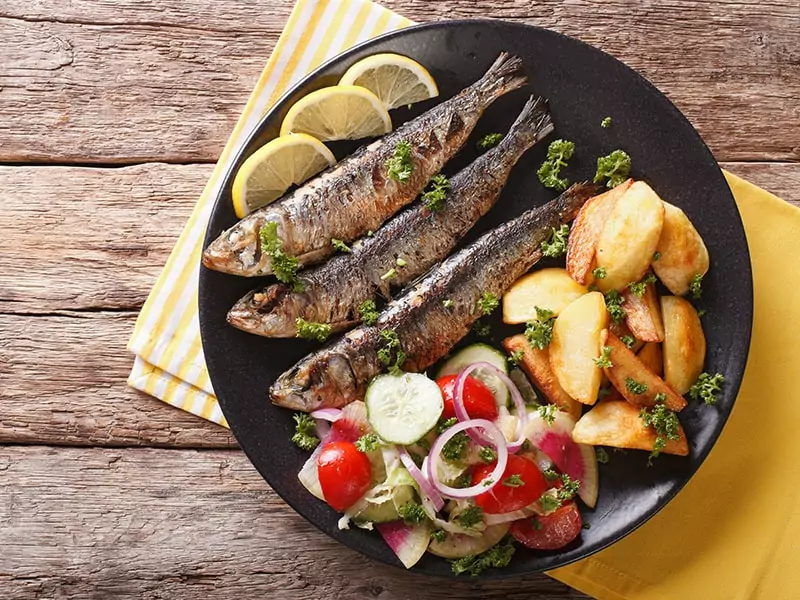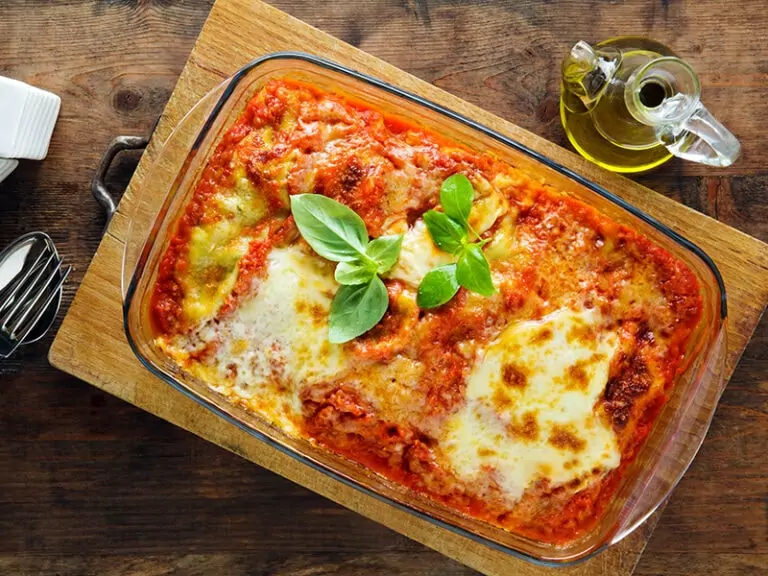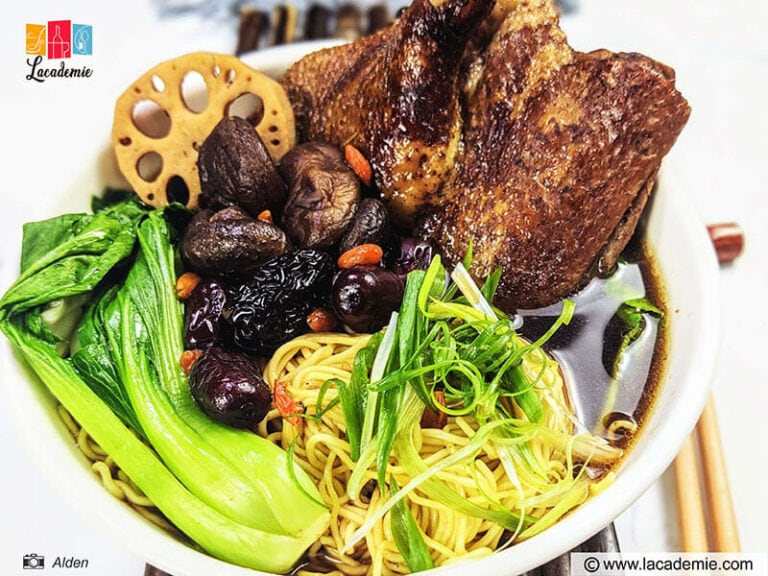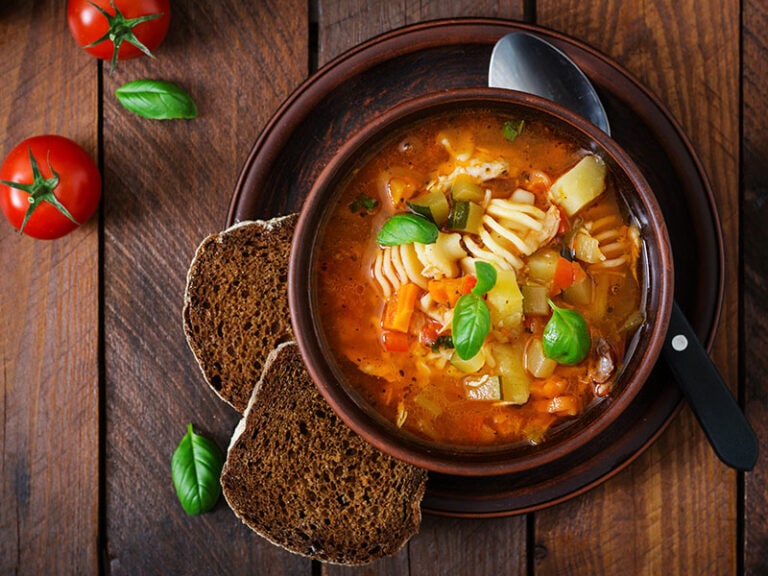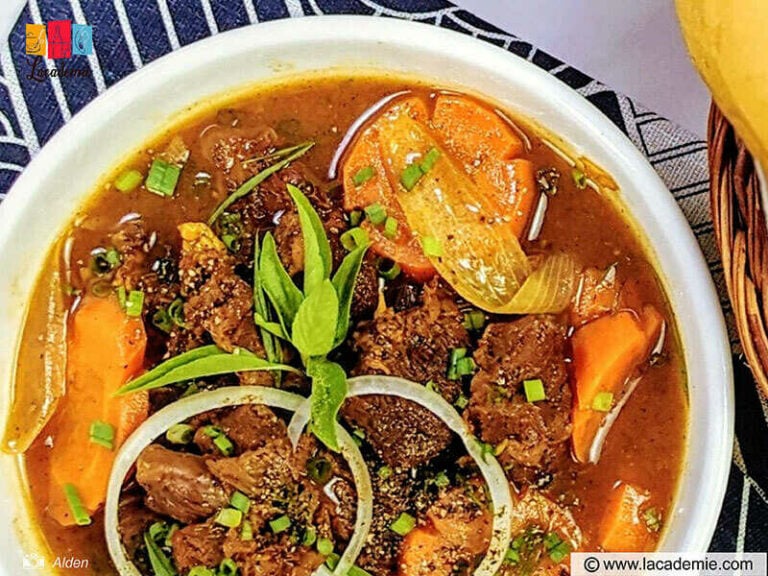When it comes to Portuguese cuisine with its unfamiliar recipes, most people will get cold feet and run away. But since you’ve come to this place, you won’t end up like them. All the dishes I present here will help you master this exotic cuisine right away.
One thing about Portuguese foods you need to know is that they are heavily influenced by other cuisines, such as Mediterranean, African, and Asian ones. So don’t be surprised if you feel these dishes below are pretty familiar.
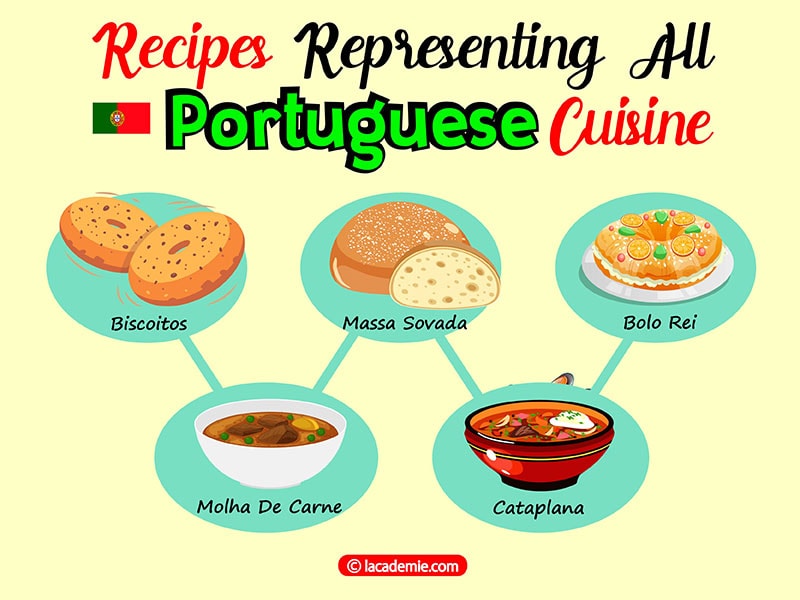
You’ll Fall In Love With These Portuguese Recipes
No matter how demanding you or your guests are, these Portuguese recipes will satisfy all stomachs. There are pastries, sweets, vegetarian, and all kinds of meat dishes here for you to choose from.
Portuguese Savory Dishes
Vegetables
- Caldo Verde (Portuguese Green Soup)
- Sopa de Tomate (Portuguese Tomato Soup With Poached Eggs)
- Peixinhos Da Horta (Fried Green Beans)
- Arroz de Tomate (Portuguese Tomato Rice)
Seafood
- Sardinhas Assadas (Portuguese Sardines)
- Bacalhau Com Natas (Cod With Cream)
- Pastéis de Bacalhau (Portuguese Salted Cod Fritters)
- Cataplana (Portuguese Seafood Stew)
- Caldeirada (Portuguese Fish Stew)
- Shrimp Mozambique
- Rissóis De Camarão (Portuguese Shrimp Turnovers)
Meat
- Cozido à Portuguesa (Portuguese Mixed Meat Stew)
- Molha De Carne (Azores Beef Stew)
- Cacoila (Portuguese Pulled Beef)
- Peri-Peri Chicken
- Arroz De Pato (Portuguese Duck Rice)
- Bifana (Portuguese Pork Sandwich)
- Francesinha Sandwich
Portuguese Sweet Treats
Tarts
- Pastel De Nata (Portuguese Custard Tarts)
- Queijadas de Leite (Portuguese Milk Tarts)
Cakes
- Portuguese Orange Cake
- Bolo Rei (King Cake)
- Bolos De Arroz (Portuguese Rice Muffins)
Pastries And Biscuits
- Massa Sovada (Portuguese Sweet Bread)
- Pão De Deus (Portuguese Bread)
- Broa de Milho (Portuguese Cornbread)
- Malasadas (Portuguese Donuts)
- Biscoitos (Portuguese Biscuits)
Puddings
- Serradura (Sawdust Pudding)
- Arroz Doce (Portuguese Rice Pudding)
Here is just some basic information. There is more for you to know in this article.
So, vamos lá!
Arriving In Portugal, You Must Try These Savory Dishes Now!
Nothing reflects one’s cuisine better than its savory dishes. From vegetables to meat or seafood, there are no two countries having them completely the same. So, let’s start your journey in Portugal with these savory dishes!
These Portuguese Vegetables Dishes Will Help Retain Your Well-Being
In Portugal, vegetarian dishes are mainly about leafy greens, green beans, and starchy vegetables. And they often use veggies to make soups. So, if you are worried about your weight, how about trying these dishes?
Caldo Verde (Portuguese Green Soup)
Once you see this signature Portuguese dish, you’ll understand its name. A bowl of soup with bright green color from the collard greens. However, it’s hard to find this ingredient outside Portugal, so you can replace it with kale or mustard greens.
Aside from it, you can add other ingredients to make your own versions, like ham hock. This soup tastes best with broa, a Portuguese cornbread. You can find this combination in Portuguese celebrations like weddings or birthdays.
Sopa de Tomate (Portuguese Tomato Soup With Poached Eggs)
Don’t have time to make a large dinner or just want something light to end your day? This tomato soup is a perfect choice for you. Take less than an hour to make, you can easily make it even on the busiest nights.
And since it combines both tomatoes and eggs, sometimes bacon or sausages, you’ll still feel satisfied with just one bowl of soup.
This Portuguese version will be the best tomato soup you’ve ever tasted.
Peixinhos Da Horta (Fried Green Beans)
Did you know that it’s the Portuguese who introduced the tempura concept to Japan? If not, well, you know it now. And this dish is the origin of the green bean tempura dish you eat today.
While it’s the origin, this dish is not much different from the regular tempura. The green beans are also coated with flour-based batter and deep-fried. You can use other vegetables like squash and bell peppers to make a small colorful plate.
Arroz de Tomate (Portuguese Tomato Rice)
Just from its name, you may have already known what its main ingredients are. Yes, they are rice and tomatoes. That’s why you can find this recipe in the South Central area more as this region is famous for its fresh tomatoes.
But this dish doesn’t contain only these components. With onions and garlic sauteed in bacon fat, this tomato rice is full of rich, smoky flavor, making it a great dish on its own or as an appetizer.
7 Portuguese Seafood Dishes Will Take You To The Ocean Right Away
Portugal is among countries owning a high-developed fishing industry, and that reflects on their seafood dishes. Coming to Portugal, you’ll enjoy all the freshness that the ocean can provide.
Sardinhas Assadas (Portuguese Sardines)
If you want to experience Portuguese’s famous fish dishes, you must count this first. Portuguese people love sardines and their flavors so much that they even make an annual festival for this fish. On that day, people will sing songs and celebrate with tons of grilled sardines.
To eat this like a Portuguese, you first need to coat the fish with salt, then grill them on a charcoal grill. And, here is the exciting part, eat the whole fish on a bread slice. Or you can go with an easier choice is enjoying it with boiled potatoes.
So, whenever grabbing a can of premade sardines no longer sound appealing to you, how about giving this recipe a go? Maybe you’ll fall in love with sardines, just like the Portuguese.
Bacalhau Com Natas (Cod With Cream)
Another fish dish for your Portuguese experience is this bacalhau. In Portugal, it means “dried salted cod,” a familiar way to prepare cod.
In terms of popularity, bacalhau isn’t losing to sardines. It’s been said, Portuguese people even have 365 bacalhau recipes so that they can eat them for a whole year.
This time, I’ll show a famous bacalhau cooking method called “bacalhau com natas,” which is “cod with cream.” Just like its name, this dish contains layers of cod and cream baked in the oven.
As delicious as this Portuguese recipe for cod is, it’ll not be complete without a compatible side dish for cod fish. This is especially true when you need a hearty, fulfilling, and nutritious meal. Personally, I think green salads are the best match for this lip-smacking dish.
You won’t stop devouring this cod with cream. Watch this video to know more:
Pastéis de Bacalhau (Portuguese Salted Cod Fritters)
These fritters actually have two different names. The North Portugal region calls them bolinhos de bacalhau (which means cod cake), while this name is mainly used in the Southern area.
No matter what name they’re called, these fritters stay the same in both cooking method and their appearance. In fact, their look is what people use to differentiate them from other fried dishes. Cod cakes in Portugal have a distinct oblong-like shape, which sets them apart.
Cataplana (Portuguese Seafood Stew)
While many recipes are named after their ingredients, appearance, or origins, this dish got its name from a cooking tool – a clam-shaped copper pot. All the components will sit inside the pot, and chefs will only open the lid when serving.
Thanks to this cooking method, all the flavors are condensed to the dish, producing a unique ocean scent. There are two versions of cataplana: One is full of various kinds of seafood, such as prawns, shellfish, and fish, while the other only includes pork and clam.
Caldeirada (Portuguese Fish Stew)
Compared to cataplana, caldeirada is a bit less overwhelming as it includes primarily different fishes and sometimes shellfish or clams.
You can use any fish you like, from oily fish like sardine, tuna to white fish like cod or haddock. But the preferred choice is fish with firm flesh, so it won’t fall apart when cooking.
Caldeirada varies from one region to another. Some make it a light soup with a bit of white wine and olive oil. In contrast, other areas want the broth thicker. So, you can freely create your own version.
This Portuguese fish stew indeed brings a portion of the ocean to your home.
Shrimp Mozambique
I know Mozambique is in Africa, but this dish is 100% Portuguese. It even uses all typical Portuguese ingredients like red wine and piri-piri – a red pepper in Portugal. Habanero chili or Spanish paprika is a decent substitution if you can’t find it.
And you are free to alter the spiciness in this dish to your liking. And don’t forget a bit of saffron for the finishing touch. Serve this dish with rice or French fries for a beautiful dinner meal.
Rissóis De Camarão (Portuguese Shrimp Turnovers)
There are many ways to translate this dish to English: shrimp turnovers, shrimp croquettes, shrimp empanadas, and many more. But let’s just go for the first choice for the time being.
This dish is a favorite snack choice of many Portuguese people with a creamy shrimp filling and a crunchy bread crumb coating. But you can make them as an appetizer or side dish for dinners, lunches, and friend gatherings.
Let’s try tackling these Portuguese shrimp turnovers together!
These Meat Recipes Are Juicy Beyond Belief!
There’s no cuisine existing without meat dishes. In Portugal, that’s no different. However, back in the Middle Ages, meat was considered food for royals only. So, you can think of yourself as a King/Queen when eating those dishes below.
Cozido à Portuguesa (Portuguese Mixed Meat Stew)
Meat lovers can’t skip this stew. It contains meat and even more meat, such as beef, pork, chicken, and sausages. You can find various animal parts in this dish. For example, I once found a pig’s ear when eating it.
Aside from meats, cozido also includes several vegetables like beans, carrots, turnips, and cabbages, so you don’t have to worry about nutrients. The result is such a satisfying stew that Portuguese people consider it a national treasure and heritage.
Molha De Carne (Azores Beef Stew)
This stew is so much thicker that you can just dunk your bread in and eat compared to the previous one. Portuguese often serve it with folar, their own type of sweet bread, but you can use whatever bread you like.
Another thing about this dish is it’s really fragrant. Its scent comes from all the spices like cumin and cinnamon.
Cacoila (Portuguese Pulled Beef)
If you want to tighten up your budget, this cacoila will help you last for a long time. Also, it only requires low-priced meat parts. In fact, these inexpensive cuts of meat are why this dish is so good since they can endure the long cooking time.
For an authentic cacoila, it’d be best if you get Madeira, a Portuguese red wine. However, you can switch it with other red wines, especially ones fortified with brandy, so they have the same flavor.
Make this cacoila for your burger party now! Watch this video to know more:
Peri-Peri Chicken
Portuguese people don’t need KFC since they already have this peri-peri chicken. What sets this dish apart from all the fast-food chicken is its piri-piri-based paste. Piri-piri is another name of the bird eye chili, which is found in South Portugal.
If you follow the traditional way, it might take hours to make this dish. However, with your oven, you can reduce the cooking time to an hour or so without affecting its taste.
Arroz De Pato (Portuguese Duck Rice)
This dish never fails to impress me with its ducky flavor. First, you need to cook in a broth. Then, after the duck is cooked, take that broth to make the rice. That way, your rice will be full of duck flavor and richer than ever.
However, if you feel that is too heavy for you, feel free to leave the duck skin out and just cook the meat instead. Another vital ingredient for this dish is chorizo, a Spanish sausage, as it would bring a more savory flavor to the rice.
You can’t go back to your regular rice once you try this Portuguese duck rice.
Bifana (Portuguese Pork Sandwich)
It’s no strange sight seeing Portuguese people walking with a bifana in hand, especially at night. The best street food combo in Portugal is this bifana with some beer. But of course, you can skip this alcohol if you want.
Bifana is also served at lunch or dinner with a bowl of soup for a heartier meal. Each region in Portugal has its distinct bifana, so you should travel through this country to try as many versions of this sandwich as possible.
For home chefs who love making everything from scratch, you should invest in a decent appliance for making sandwich. This allows you to make not only the best Portuguese sandwiches, but also explore various other possibilities for sandwich dishes as well.
Francesinha Sandwich
While it’s called a sandwich, this dish is not a snack like bifana. Make sure you’re starving before ordering or making it because, let me tell you this, this dish is enormous! Meat, ham, cheese, and sausages, it can even be your filling dinner.
As the main ingredients remain mostly unchanged, the difference in Francesinha sandwiches from different eateries lies in the sauce. Each place has its special sauce though the most common combination is beer and tomatoes.
Without These Sweet Treats, Your Portugal Trip Will Go To Waste!
There’s no doubt that Portuguese people are sweet lovers. Because there are so many luscious sweet treats in Portuguese cuisine, going to their bakeries is like searching through a treasure box. There are tons of mouthwatering desserts waiting for you.
The First Ones Waiting For You Are These Lovely Portuguese Tarts!
You may wonder, why tarts? It’s because Portugal’s famous for its tarts. Simple as they look, these tarts here hide an incredible flavor that leaves you speechless.
Pastel De Nata (Portuguese Custard Tarts)
When talking about Portuguese cuisine, many people will think of these custard tarts right away. Despite being considered an iconic dish in Portugal, they are just regular egg custard tarts with sprinkled sugar and cinnamon.
According to history, monks use the leftover yolks to make these tarts as egg whites are often used to starch the clothes. Nowadays, you can find them in every bakery in Portugal.
It’d be a waste if you won’t try these Portuguese custard tarts.
Queijadas de Leite (Portuguese Milk Tarts)
Here is a brother of the infamous custard tarts – the milk tarts. While they are not as well-known as the previous one, they are no less delicious.
You can imagine them as a sturdier version of creme brulee so you can eat them when holding in your hand without using spoons or forks.
And while the crust is firm and crunchy, these tarts’ interior is totally opposite. As it’s made of milk, butter, and eggs, the filling is so soft and creamy that it can melt in your mouth. Garnish these tarts with some powdered sugar and cinnamon for the finishing touch.
These Portuguese Cakes Are Really Something Else!
You can’t talk about desserts without mentioning cakes, right? Though every cuisine creates its own cakes, Portuguese ones still engrave themselves in the memory of all people who have tried them.
Portuguese Orange Cake
With its simple look, this cake is better than you could think. Aside from the sourness, you’d expect from all the citrus desserts, this dessert also tastes slightly bitter, coming from the orange zest in the batter.
With its unique flavor, this orange cake is perfect for your afternoon tea party. You can serve it with whipped cream, ice cream, or just some sprinkled sugar.
Here is a full guide to your perfect Portuguese orange cake.
Bolo Rei (King Cake)
You won’t find a Portuguese house without this cake during the New Year holiday. According to Portuguese tradition, they will start making it at Christmas and finish it by January 6th.
Bolo rei has a shape just like a crown, hence its name. Aside from the appearance, this cake also has a flavor worth being called “king.” You can find tons of dried and crystallized fruits, nuts with nuts in this sweet cake.
Nowadays, there’s another version of bolo rei named “queen cake.” Both of them share a similar look, the only difference is queen cake doesn’t use candied fruits.
Bolos De Arroz (Portuguese Rice Muffins)
They’re muffins but not entirely muffins. Sounds strange, right? That’s because these muffins use rice flour instead of regular ones, making them have the same texture as cornbread.
Besides the texture, the reason for this dessert’s popularity is also its flavor. These muffins are all about sugar, butter, and a hint of lemon that are enough to keep you eating them nonstop.
In fact, you can enjoy them at any time you want, breakfast, snack, or even at late nights.
You Can’t Escape The Desire For Those Portuguese Pastries And Biscuits
Goodbye to all the tarts and cakes! Now, I’ll lead you to a rustier choice: pastries and biscuits. While these two previous categories tend to be exclusive only to large gatherings and parties, these recipes below can be enjoyed at anytime you want.
Massa Sovada (Portuguese Sweet Bread)
Every cuisine has its distinct sweet bread, and massa sovada is the representative of Portugal. Traditionally, the Portuguese will eat this bread at Christmas and Easter. But actually, you can find and buy it in any bakery at any time.
Regular massa sovada uses yeast flour and a bit of lemon peel for more fragrance. However, the Easter version is pretty different as it requires hard-boiled eggs. Thus, it also gains another name, folar.
This Portuguese sweet bread is suitable for your breakfast, snack, or even dinner.
Pão De Deus (Portuguese Bread)
Despite its fancy name (Pao de Deus means bread of god in Portuguese), this bread is actually a simple dish to make. You just have to pay attention to the dough.
Pao de Dues’s dough is often flavored with lemon zest, vanilla, or rum for more flavors. You need these additional ingredients to emphasize the coconut filling.
After baking them, you can add some shredded coconut as a topping for extra crunchiness.
Broa de Milho (Portuguese Cornbread)
Although it’s a part of the cornbread group, broa doesn’t feel tender or crumble like other regular kinds. Instead, it tastes pretty dense with a crispy and crusty texture, just like sourdough. However, it still has the sweet corn flavor.
Due to those characteristics, broa often accompanies various Portuguese soups, such as Caldo Verde. You can spread some butter on top, so it’s easier to digest.
You won’t realize what your life lacks until you try this Portuguese cornbread. Let’s watch this video below:
Malasadas (Portuguese Donuts)
Malasadas are the Portuguese equivalent of American fried donuts. Sellers often flavor them with lemon zest, sugar, or cinnamon. However, unlike other donuts, traditional malasadas don’t have any filling, making the inside stay moist and fluffy all the time.
Of course, today, you can buy those with filling. And let me tell you, there are tons of variants for you to choose from: custard, coconut, passion fruit, pineapple,…
Don’t hesitate to make a large batch of this dessert. After all, there are many ways to retain your donut’s freshness over a long time. Avid donut lovers might even consider if it’s a good idea to freeze donuts so that they can always have this treat ready at hand.
Biscoitos (Portuguese Biscuits)
If you want something to nip on while reading or working, there’s nothing better than these biscuits. With vanilla and lemon zest in the dough, they don’t taste all sweet and dull like those commercially made.
However, if you want these biscuits a bit sweeter, you can make icing for them instead of adding sugar to the recipe. It’s more fun, and you get to garnish them to your liking. This snack goes best with coffee or tea, so you’d better prepare them beforehand.
These Portuguese Puddings Will Surely Surprise You With Their Flavor!
For me, these puddings deserve a whole category for themselves as they are so delicious. Believe me, you won’t remember any standard puddings after trying these!
Serradura (Sawdust Pudding)
Contrary to the other recipes, this dessert has a pretty off-putting name. Who on Earth wants to eat a sawdust pudding? Does it really taste like sawdust? Of course not.
Let me assure you, this name doesn’t come from its flavor but rather its appearance since serradura is made initially of biscuit crumbs.
Aside from crumbs, traditionally you just need to make some whipped cream to complete this pudding. From then, you can add other ingredients like chocolate or fruits to make your own version.
Arroz Doce (Portuguese Rice Pudding)
Forget all regular chilled rice puddings, this arroz doce has become my new favorite. What sets it apart is that this Portuguese kind uses short-grain rice, making it creamier than other variants.
Portuguese people also flavor this dish with lemon peel and cinnamon for more flavors. Arroz doce tastes the best when served warm or at room temperature, but you can chill it in the fridge like other rice puddings.
You’ll love this Portuguese rice pudding like I do. Watch this video to know more:
Have These Portuguese Recipes Met Your Expectation?
Encountering a new cuisine is like meeting new people. It’s nerve-wracking, it’s scary, and it doesn’t always end in good notes. But after all those things, the experiences you’ve gained are priceless.
So, don’t hesitate to try cooking these dishes. If some are too hard for you, you can have your friends read this article and help you. Or you can just comment your troubles here so that other readers and I can help.
Nutrition Facts
6 servings per container
- Amount Per ServingCalories402
- % Daily Value *
- Total Fat
21.6g
33%
- Saturated Fat 5.4g 25%
- Cholesterol 35mg 12%
- Sodium 1510mg 63%
- Potassium 1146mg 33%
- Total Carbohydrate
40g
14%
- Dietary Fiber 5.8g 20%
- Sugars 3.8g
- Protein 17.4g 34%
- Calcium 164%
- Iron 3%
* The % Daily Value tells you how much a nutrient in a serving of food contributes to a daily diet. 2,000 calories a day is used for general nutrition advice.


